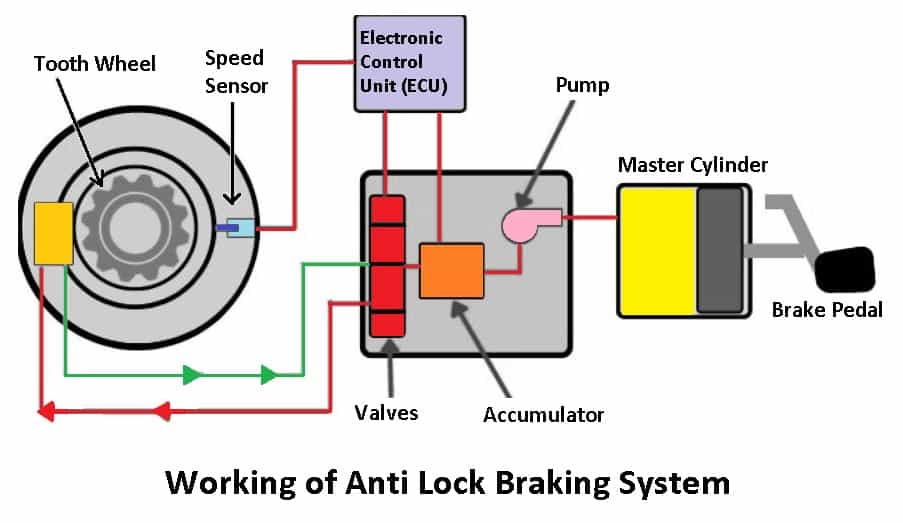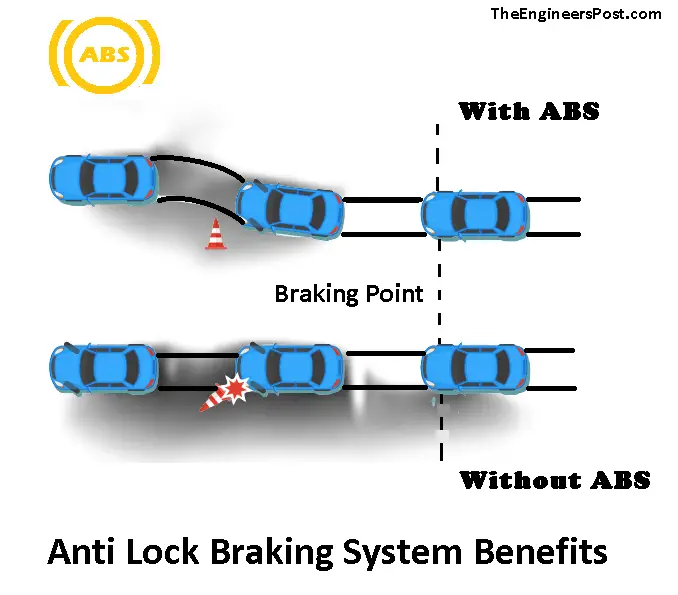In this article, you’ll learn what is anti-lock braking system? Its diagram, parts, working, types, advantages, and disadvantages all are explained with pictures.
Also, you can download the PDF file at the end of this article.
What is Anti Lock Braking System?
ABSs are anti-lock braking systems that prevent vehicles from skiing or sliding. These systems are commonly found on aircraft and in vehicles on land, such as buses, cars, motorcycles, and trucks.
ABS prevents the wheels from locking up when you brake, thus maintaining traction on the road. This allows the driver to maintain more control over the vehicle. ABS basically works on the principles of threshold braking and cadence braking.
The ABS system operates at a much higher speed and works much more effectively than other types of braking systems. ABS has introduced into production vehicles over a decade ago, but today they are more sophisticated and effective than ever before.
In modern ABS models, the front-to-rear bias can be adjusted, and the wheel lock is prevented. ABS comes in a variety of configurations, including electronic brakeforce distribution (EBFD), traction control system (TCS), emergency brake assist (EBA), and electronic stability control (ESC). Let’s discuss the components of ABS system.
Read Also: What is the function of Wankel Rotary Engine? [PDF]
Parts of Anti Lock Braking System
The following are the important parts of anti-lock braking system:
- Speed sensors
- Pump
- Valves
- Controllers
#1 Speed Sensors
The anti-lock braking system needs to be aware of when a wheel is about to lock, to do this, it uses a speed sensor. Speed sensors are located on each wheel or, in some cases, in the differential. To generate a signal, these sensors use a magnet, a Hall effect sensor, or a toothed wheel and a coil of electromagnetic energy.
#2 Valves
Each brake controlled by ABS has a valve in its brake line. Some systems have three positions for the valve:
- Position one has the valve open; the master cylinder’s pressure is passed directly to the brake.
- In position two, the valve blocks the line, separating that brake from the master cylinder. As a result, if the driver pushes the brake pedal harder, the pressure won’t rise further.
- During position three, the valve releases some brake pressure.
#3 Pump
In ABS, the pump is used to restore pressure to the hydraulic brake after the valves have been released. A signal from the controller will release the valve upon detection of wheel slip. Using the pump, the braking system is restored to the desired pressure level after the valve releases the pressure supplied by the user.
#4 Controllers
Every wheel speed sensor sends information to the controller, which is a type of ECU unit. The controller receives a signal when a wheel loses traction. The controller will then limit the brake force (EBD) and activate the ABS modulator, which turns the braking valve on and off.
Read Also: Important Parts of Car Wheel Assembly and Its Function [PDF]
How Does Anti Lock Braking System Work?

As you already know, anti lock braking has four primary components speed sensor, valves, pump, and controller. The speed sensor monitors how fast the wheels are rotating. Valves allow to block and release the pressure on the brakes.
Pumps are filled with hydraulic brake fluid and apply pressure to the brake drums on demand. A controller is the electronic control unit (ECU) is the brain of an ABS and uses data from sensors to determine whether to pump the brakes or not.
The sensors located on the wheels monitor the speed of each wheel. When sensors detect that your car’s tires are locking up, the ECU reads the signal from each sensor and sends the to the valves of the respective wheels.
Then valves rapidly apply and release the brake automatically to keep your vehicle tires from skidding and help keep the driver in control of the vehicle. If speed sensors detect the speed of any of the wheels is reducing drastically compared to others, the ECU sends the signal to the valves of the respective wheel to reduce the brake pressure, and the valves get closed.
After this, the wheels start to accelerate again, and the signal is sent to the ECU one more time, which in turn sends the signal to open the valve and increase the brake pressure hence the brakes are applied.
The cycle repeats itself until the application of brakes becomes normal. So essentially, ABS works in three stages:
- The brake pedal is pushed.
- While the sensor detects skidding or locking.
- ABS pumps the brakes.
Read Also: Disc Brake vs. Drum Brake: What’s The Difference?
Types of Anti Lock Braking System
Following are the main types of anti lock braking system:
- Four-channel. Four-sensor ABS
- Three-channel. Four-sensor ABS
- Three-channel, Three-sensor ABS
- Two-channel, Four-sensor ABS
- One-channel, One-sensor ABS
#1 Four-channel, Four-sensor ABS
As the name suggests, this type of ABS has a speed sensor on all four wheels and a separate valve on each wheel. Four-channel, Four-sensor ABS is considered the best system among other types. The reason for this is that it monitors each wheel individually to ensure the greatest braking force possible.
#2 Three-channel, Four-sensor ABS
Using this configuration, all four wheels are equipped with speed sensors, and each front wheel has a separate valve. One valve has been installed for both the rear wheels. Because of this arrangement, these are commonly found in older vehicles.
#3 Three-channel, Three-sensor ABS
This type of ABS offers both front wheels with an individual valve and speed sensor. The rear wheels, however, must share a speed sensor and valve, which is located in the rear axle. Three-channel, Three-sensor ABS is widely used on four-wheel pickup trucks.
The drawback of this system is that the rear wheels share a valve and speed sensor. Both the valve and sensor are monitored simultaneously, so both wheels must be locked for the ABS to be triggered. A brake’s effectiveness will be reduced if only one rear wheel locks. In addition, the system is easy to recognize as there are no individual speed sensors for the rear wheels.
#4 Two-channel, Four-sensor ABS
This ABS has a speed sensor on each wheel and a control valve for each front and rear wheel as a pair. In the event that the speed sensor detects lockup in any wheel, the control module pulses both valves on that end of the vehicle. Passenger cars built in the late ’80s and early ’90s commonly use this system.
#5 One-channel, One-sensor ABS
As the name suggests, this type of ABS is fitted with one valve and one speed sensor to monitor all four wheels. It works similarly to the three-channel ABS and is usually located in the rear axle. In addition, with this ABS, one rear wheel may lock, which reduces brake effectiveness.
This system is pretty easy to recognize on a vehicle, as there are no individual speed sensors for either wheel. As one valve controls both rear wheels, one-channel ABS systems are commonly found on pickup trucks, vans, and SUVs.
Read Also: Types of Differentials System In Car [Understand Them Now]
Why Anti Lock Braking System Is Essential In Your Car?
To understand the requirement of the ABS system in every vehicle, let us consider an example. If you are driving your car on the road, unexpectedly, an obstacle comes in front of you, and you need to apply the brake with full force.
This locks the wheels, and your car will slide on the road. While skidding, you lose your steering control and cannot steer the car in the desired direction. Eventually, you hit that obstacle and face an accident.

Let’s take another situation where you are driving a car equipped with an anti-lock braking system. While driving, when you face an obstacle on the road and suddenly apply the brakes with full force.
Now this time, your car’s ABS prevents the wheel from locking up and prevents skidding. At the same time, you can steer your car correctly and prevent it from hitting the obstacle. Thus, the ABS system prevents the vehicle from slipping, provides more control, and prevents accidents.
Read Also: What’s the purpose of a propeller shaft in your car?
Advantages
- Anti lock braking system helps in reducing the braking distance as the wheel does not waste skidding distance.
- This prevents the wheel from locking up and therefore allows for precise braking on wet gray surfaces.
- ABS allows the car to steer around objects, as you still hold onto the wheels under intense braking.
- Since it is a safety device with a track record of effectiveness, insurers often give specific discounts to customers for having an ABS on their vehicle.
- The traction control system has the highest potential in ABS.
- It makes better use of brake pads and brake discs.
Disadvantages
- The cost of ABS brakes is high as it adds to the total cost of a vehicle.
- Maintenance costs are also high because the sensors on each wheel are expensive.
- Since the ABS system uses footed braking, this results in inconsistent stopping distances on different surfaces under variable conditions.
- Well-experienced drivers can manually brake more often than ABS brakes.
- ABS involves using an additional sensor and a controller, which makes the system complex.
Wrapping It Up
In conclusion, the anti-lock braking system (ABS) restores traction to your tires in emergency situations. In slippery and dry conditions, it offers advanced vehicle control, while in loose, snow-covered conditions, it offers better stopping distance.
That’s it. Thanks for reading. I hope I have covered everything about the “Anti Lock Braking System.” If I missed something, or if you have any doubts, let me know in the comments. If you liked this article, please share it with your friends.
Want free PDFs direct to your inbox? Then subscribe to our newsletter.
Download PDF of this article:
You might like to read more in our blog:
Incisive lecture on braking system.
Thanks for your feedback.